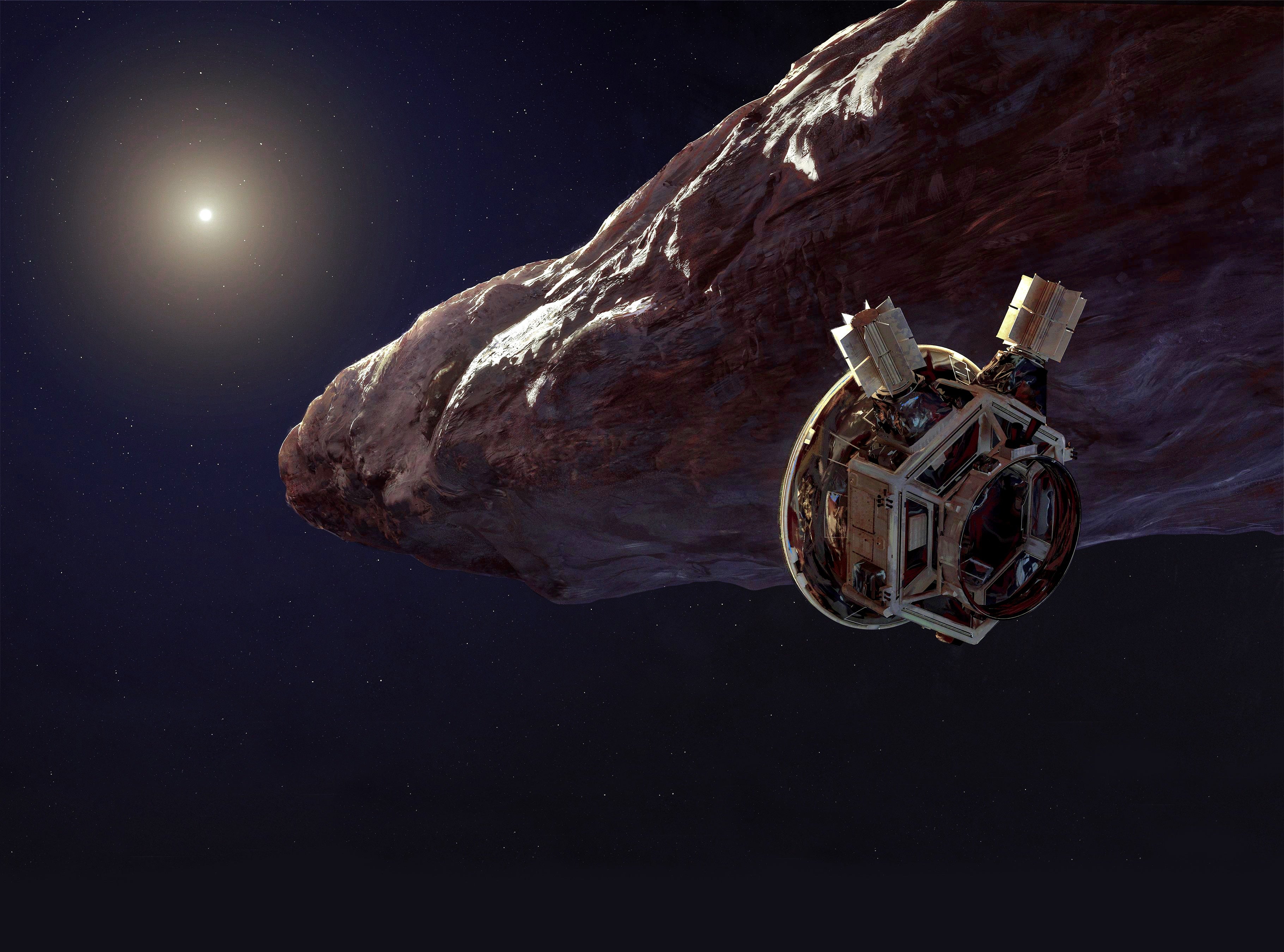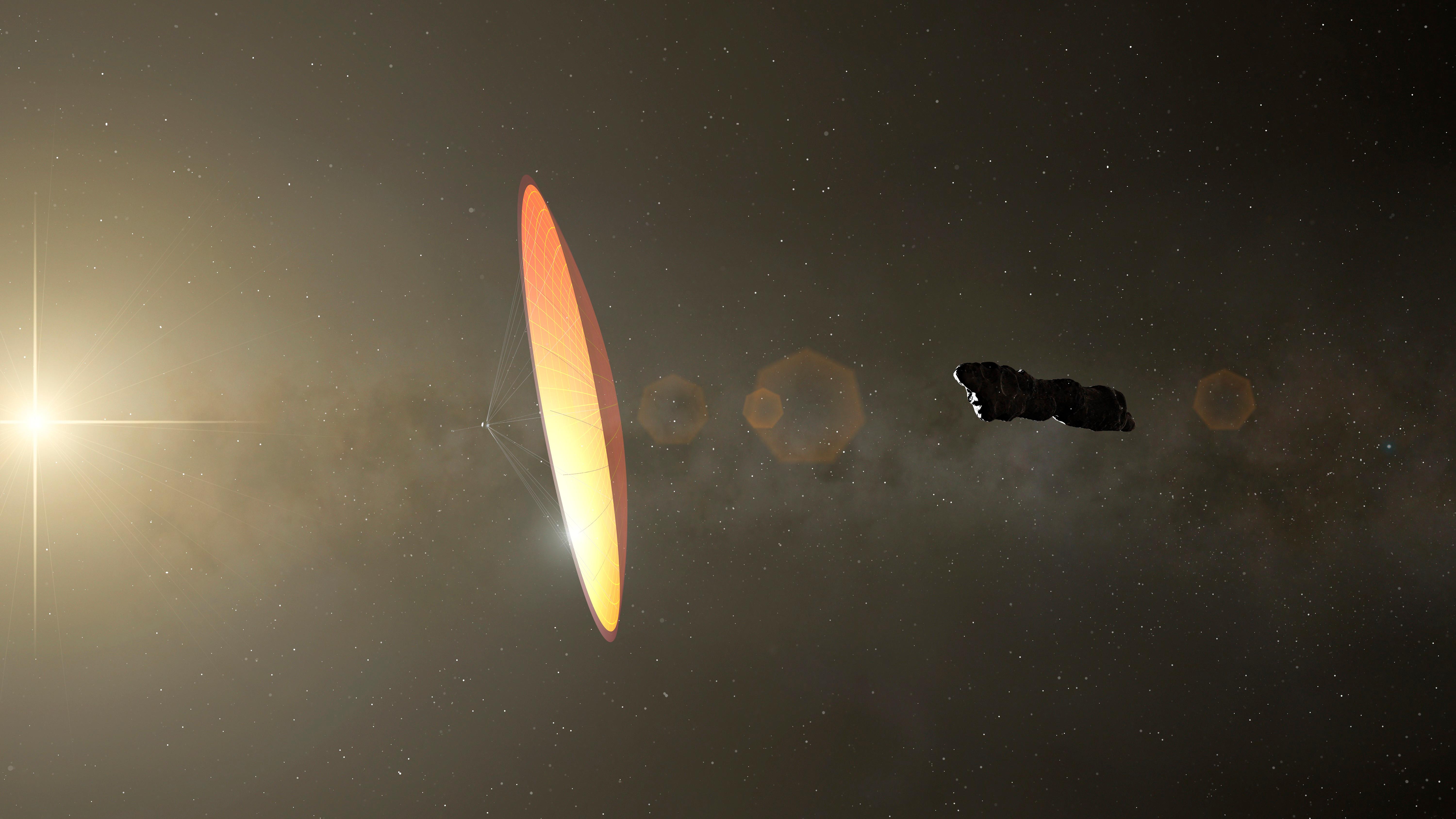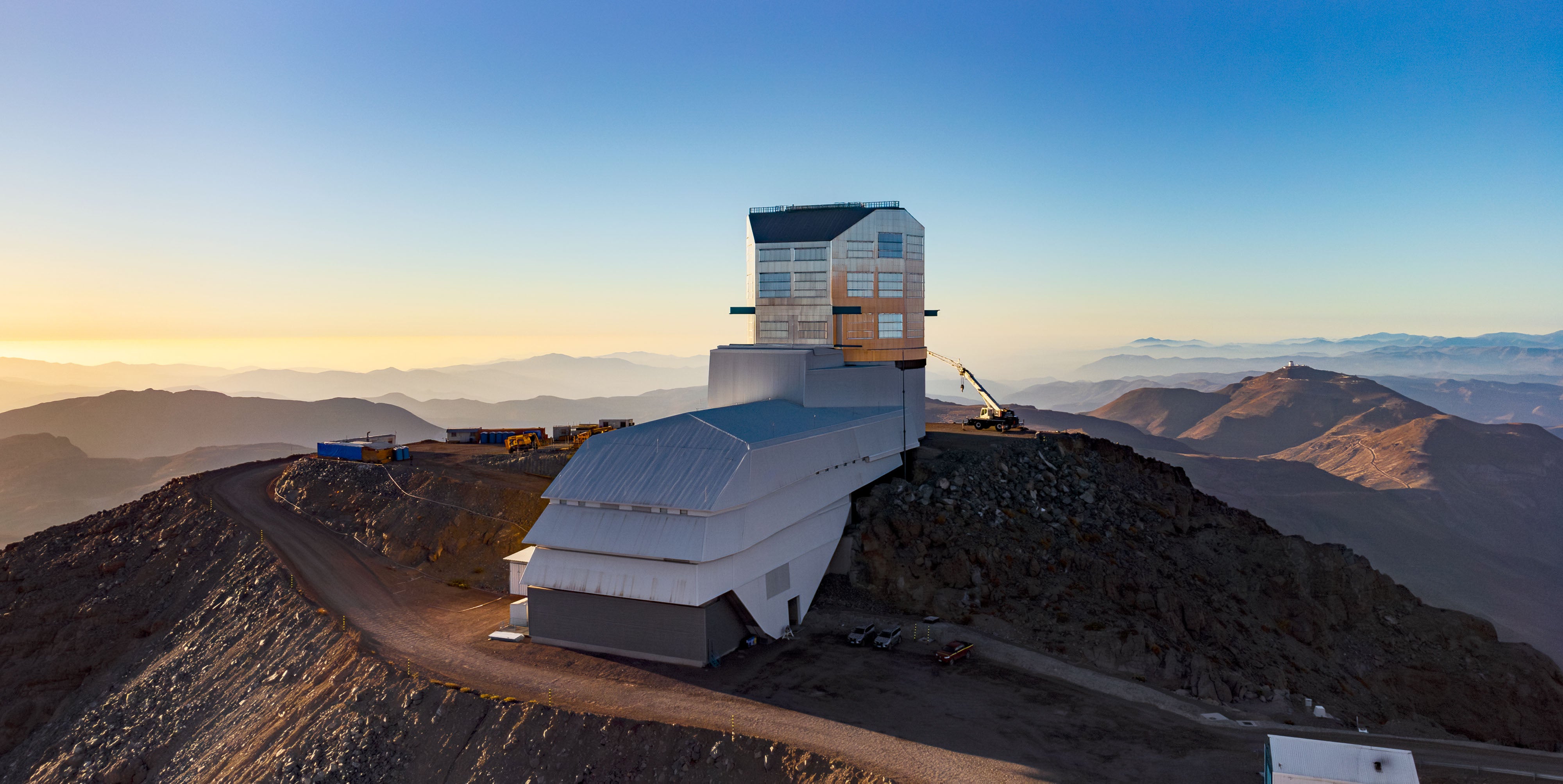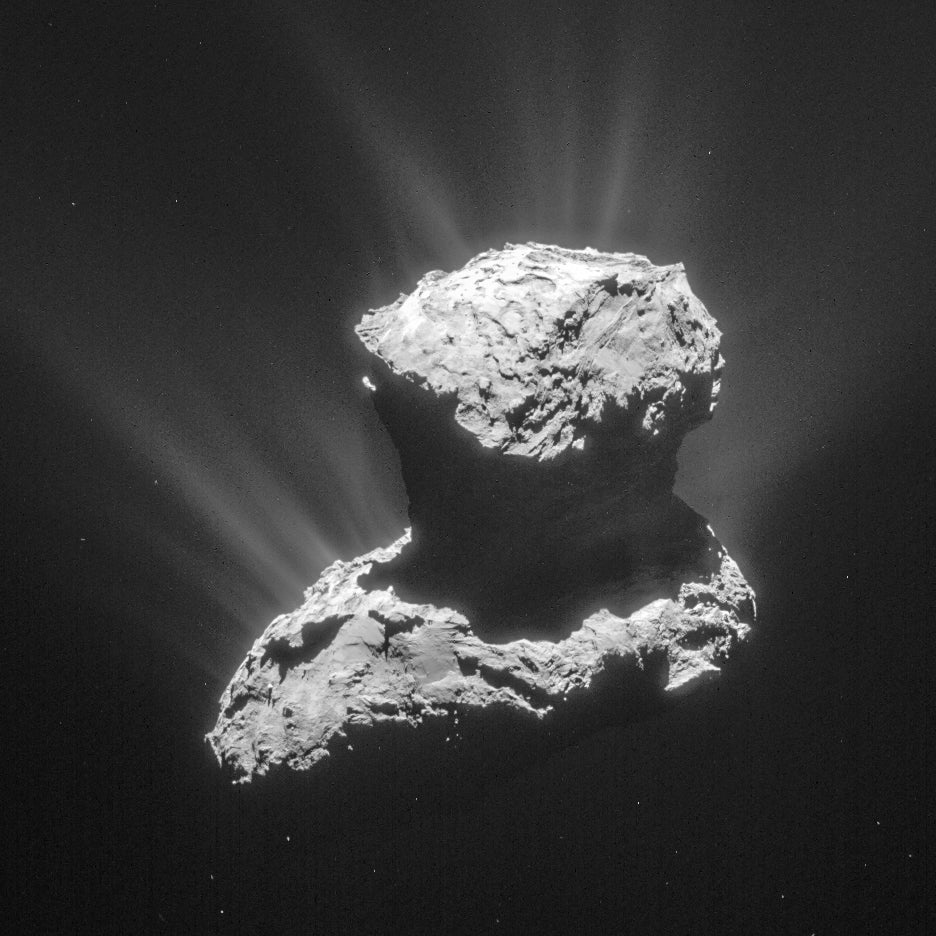
1I/2017 U1 (‘Oumuamua) was discovered in October 2017; shortly after, it was determined to be the first object ever seen inside the solar system that had come from beyond it. But by the time its origins had been discerned, the interstellar interloper had already rounded the Sun and was speeding away at some 85,700 mph (138,000 km/h). Just an estimated 1,300 feet (400 meters) across, it faded from view of even the most powerful telescopes within weeks.
The only way to gather more data and uncover its true nature would be to send a spacecraft to study it up close. But uncertainties in ‘Oumuamua’s exact trajectory, the difficulty of detecting its ever-dimming light, and its rapid retreat make the idea of designing, building, and launching a mission in time to catch up to it seem utterly impossible.
Or is it?
Several groups of researchers have been working to find ways of reaching this increasingly distant object. They have come up with a variety of proposals that could lead to a close-up encounter with ‘Oumuamua within decades. And if that doesn’t work out, others are working on a mission to rendezvous with the next interstellar object that comes wandering by.

Strange visitor
Why bother with such a mission? Because ‘Oumuamua — named after a Hawaiian word for “visitor” and designated 1I as the first interstellar object found — is unique and tantalizing for many reasons.
As astronomers observed it, its brightness cyclically rose and fell. Analysis of this pattern indicated the object was not only tumbling, but it had a shape unlike anything seen before in space. Either a long, thin cylindrical object or a large, flat, disklike shape could account for these variations in brightness, but no known asteroids have a shape that extreme.
More significantly, as ‘Oumuamua left the Sun behind, it sped up in a way that could not be explained by gravity alone. Sometimes comets speed up on their outbound journeys as a result of outgassing, as the Sun’s heat boils off volatile materials like water ice and frozen carbon dioxide. But that process leaves a clearly visible trail of gas and dust — the comet’s tail. ‘Oumuamua emitted no such visible trail, so its movement could not be explained by such emissions either.
Some astronomers have proposed that ‘Oumuamua is a chunk of frozen hydrogen or a hydrogen-helium mix, like an iceberg, whose evaporation might account for the object’s acceleration without leaving a detectable trail. Alternatively, it could be a kind of loose agglomeration of particles or filaments, so lightweight that the pressure of the solar wind alone could rapidly push it outward without the need for outgassing to propel it.
Or perhaps there’s another explanation: Astrophysicist Avi Loeb, former chair of the astronomy department at Harvard University, finds ‘Oumuamua’s behavior so strange that he has argued in a series of peer-reviewed papers and a popular science book that the object is most likely a relic of alien technology.
Loeb says that natural explanations for ‘Oumuamua all invoke “rocks of a type we’ve never seen before” and lack a plausible explanation for how they might have formed. He argues that an artificial origin can better explain its anomalous features. In addition to its strange shape, if the object is made of thin, flat, lightweight material, it could be acting as a solar sail, propelled outward by the force of sunlight. No such object could arise naturally, he says. It would have to be some structure built by a sophisticated alien civilization — if not a dedicated solar-propelled craft, then perhaps a piece of an alien Dyson sphere, a device to collect the energy from a star.
Many astronomers are skeptical of Loeb’s case, and contend that ‘Oumuamua is an ordinary asteroid, albeit one on an unusual trajectory. Karen Meech, an astrobiologist at the University of Hawai‘i who led the characterization of the object after its discovery, says “its characteristics were consistent with a planetesimal with cometary activity.” Pointing out that we only have about a week’s worth of data from its passage, she stresses, “expecting to have a complete understanding of anything with so little data is unrealistic.”
She adds that “the lack of detection of gas was not a mystery. By the time we could get on the object it was faint for doing high-quality spectroscopy, where one can detect gas.” And follow-up observations using the Spitzer space telescope were “not completely inconsistent” with limits predicted for the amount of outgassing needed to explain its motion, she says.
Nevertheless, Meech agrees that close-up observations of ‘Oumuamua or any similar object would be useful. “If we had been able to have a close-up image of it, that would have been fabulous!” she says. “I think an in situ mission would be spectacular. Then we could get a good chemical characterization of any gases coming off — perhaps even isotopic ratios” to better understand its formation and origin.
And if Loeb is right, “if you can tell the composition, you can say that the composition is such that nature never produces such things,” he says. “Or you can tell the structure, the shape of it. … If it looks like a spacecraft, it’s definitely different from a rock. So, what you need is detailed enough information — especially if it has signatures of technology.”

How Rubin will change our view
The nearly completed Vera C. Rubin Observatory houses the 8.4-meter Simonyi Survey Telescope, equipped with a 3,200-megapixel CCD camera — the largest ever built. Once operational, it will continuously survey the entire Southern Hemisphere sky every three to four days for 10 years. This immense effort is called the Legacy Survey of Space and Time (LSST).
In 2017, ‘Oumuamua was spotted by the 1.8-meter PanSTARRS1 telescope on Maui. The object was discovered less than a week after making its closest approach to Earth and more than a month after its closest pass of the Sun (called perihelion). In a 2019 interview, astrobiologist Karen Meech told Astronomy that the Vera C. Rubin Observatory, had it been operating at the time, should have spotted ‘Oumuamua some three months before PanSTARRS1, before the object had passed perihelion.
The immense database LSST will create — logging some 20 terabytes of data per night for a total of 2 million images over the course of a decade — will be ideal for spotting changes in the sky, including the motions of asteroids and comets. This includes some 6 million moving objects in our solar system, some of which will be only visitors, passing through from other star systems. In a 2023 paper available on the arXiv preprint server and accepted for publication in the Planetary Science Journal, researchers estimated LSST could find as many as 70 ‘Oumuamua-like interstellar objects each year, with sizes averaging 160 to 1,970 feet (50 to 600 m), though the number heavily depends on how common such travelers are through space, how fast they are moving, and how frequently they visit our solar system.
Catching up
Loeb himself is convinced that a mission to catch up with ‘Oumuamua is impossible, both because of the enormous speed required and the difficulty of finding the small object in the vastness of space. But others have published a number of plausible mission designs to reach ‘Oumuamua within a reasonable timeframe of a few decades.
The key to catching up to ‘Oumuamua is building up enough speed to overtake the object, which is zooming away at some 16 miles per second (26 km/s). Existing chemical rockets are not capable of reaching such speeds on their own. But they could by using slingshot flyby maneuvers — dipping close to the Sun, Jupiter, or other planets — to gain speed and adjust trajectory. This is a variation of the technique used to get interplanetary probes like the Voyagers to the outer planets. Called a gravity assist or Oberth maneuver, it involves passing close to a large mass, such as a planet or the Sun, and adding a rocket boost just as the spacecraft reaches its closest point, providing significant acceleration.
Adam Hibberd, an independent software engineer based in the U.K. who has worked on the trajectory optimization software for the European Space Agency’s (ESA) Ariane 4 rocket, was already developing software of his own for designing interplanetary trajectories when he learned of ‘Oumuamua’s discovery. He was testing the software by recreating historical missions, he says, “when this strange object appeared in our heavens that was the first interstellar object to be discovered. … I decided to solve missions to this object with my software, which seemed like an obvious thing to do.” He soon found some workable trajectories.
Shortly after, he joined a group called Project Lyra, which had formed within months of ‘Oumuamua’s discovery. The team has devised and published a variety of flight plans that could make the rendezvous possible. One such scenario, using a launch date in 2030, would be able to reach ‘Oumuamua within about 22 years, he says.
Initial ideas involved close passes to the Sun, which would require extensive shielding to protect the craft from the heat, imposing a severe penalty on payload mass. So Hibberd and others began working on similar maneuvers that avoided the Sun and used Jupiter’s mass instead.
The tricky part is “you have to generate enough speed to get to Jupiter from Earth,” Hibberd says. He and the Project Lyra team found two possible ways to do this with a series of slingshots past the inner planets. Both options, he says, would get a spacecraft to Jupiter with plenty of fuel left to carry out the gravity-assist maneuver there, which would fling the craft onward toward ‘Oumuamua. The trip would take about 31 years — about nine years longer than trajectories that involve a risky close approach to the Sun.
Marshall Eubanks, chief scientist at Space Initiatives Inc. and one of Project Lyra’s mission designers, says that he feels it is inevitable that a mission will be sent to ‘Oumuamua, one way or another. Already, he points out, people are coming up with proposals to send missions to the planets of nearby stars, yet even a century from now ‘Oumuamua will still be vastly closer than such destinations.
“In a hundred years, it’ll only be about 150 AU away,” he says. (One AU, or astronomical unit, is the average distance from Earth to the Sun.) “That’s a huge distance, but it’s a lot closer than Proxima Centauri, so why not go there too?” he asks. At about 4.24 light-years — more than 268,000 AU — Proxima Centauri is the closest star to the Sun.
It’s “certainly not physically impossible” to catch up to ‘Oumuamua, Eubanks says. “It’s certainly not beyond our technical expertise.” Such a slingshot-based mission could be carried out with existing rockets such as the Falcon Heavy from SpaceX, he says.
Some researchers argue that we should just wait for the next such object, Eubanks says, since new telescopes like that of the Vera C. Rubin Observatory — scheduled to begin operations next year — will potentially discover many such objects. But with only two interstellar objects found so far, we really don’t know how scarce such objects may be. We also don’t know whether any others we find will be highly unusual like ‘Oumuamua. The only other interstellar object we’ve found is Comet 2I/Borisov — and that was a fairly humdrum, typical-looking comet.
“If you really think [‘Oumuamua] is an object that’s a real outlier, you should want to go and investigate it,” Eubanks says. “You’ll never solve it otherwise.”

Locking on target
Getting a rocket moving fast enough is only half the problem. You also have to know where you’re going — and in this case, that’s not trivial. Because of the small number of observations and their limited precision, the uncertainty in ‘Oumuamua’s present position is on the order of the distance between Earth and the Moon. “You’ll have a hard time finding it out there in the dark. It’s not a big object,” Eubanks says.
One option is to send a scout mission to pinpoint the location before launching a larger spacecraft to get close for measurements and observations. This precursor could take two forms, Eubanks says. It could be one spacecraft with a large telescope, perhaps half the size of Hubble, to scan the sky for the object. Or we could send a swarm of hundreds or thousands of tiny spacecraft to fan out and blanket the survey area. The Breakthrough Starshot project is currently working on developing this technology (and has substantial financial backing), with the aim of sending such probe swarms to the planets of nearby stars.
The tiny spacecraft would be thin disks, perhaps the size of frisbees, propelled by laser beams aimed at them from somewhere on Earth, the Moon, or in space. But even once this technology is developed, reaching anything in the solar system is still going to be much easier than trying to reach even the nearest star, Eubanks says. “And 1I is still in the solar system, even though it’s not of the solar system,” he stresses. Such laser-propelled craft could theoretically make it to ‘Oumuamua in just a couple of years.
Even these scout probes would provide significant return, he says: If one finds ‘Oumuamua and reports back its position, even with no further data, that would reveal whether the object had continued to experience non-gravitational acceleration after it was last seen and if so, how much.
Any follow-up mission would have to be much larger, at least equivalent to NASA’s New Horizons spacecraft that studied Pluto up close and is still exploring the Kuiper Belt. Such missions cost on the order of $1 billion. It’s quite possible that no government, or even individual billionaire, would be willing to put up the money for such a mission, which could end up either failing to find its target or getting there and finding a relatively ordinary rock.
The next ‘Oumuamua

Regardless of whether ‘Oumuamua ever gets visited by a spacecraft, there’s always next time. And there is one mission already fully approved and funded that may be ready when the next interstellar object comes along.
ESA’s Comet Interceptor is scheduled to launch in 2029 with one large spacecraft and two smaller probes attached. The craft will travel to the L2 Lagrange point of the Earth-Sun system, about 932,100 miles (1.5 million km) beyond Earth, and wait there for either a newly found interstellar object or a never-before-seen pristine comet from the outer solar system. It will then fly by the target and take images, spectra, and other measurements. About 200 people are currently working on the mission. “It’s the first implementation of a so-called rapid-response mission,” says Comet Interceptor Project Scientist Michael Kueppers.
“We have a range of instruments,” says the project’s interdisciplinary scientist, Geraint Jones. Comet Interceptor carries three different cameras, he says — one on the main craft and one each on the two smaller probes — to provide three-dimensional views as they zip past. The mission will also take infrared images and carry a mass spectrometer to measure the composition of gases that may be emanating from a comet.
The main craft is designed to pass within about 620 miles (1,000 km) of the comet. At that distance, its main camera will have a resolution of about 26 feet (8 m) per pixel, Kueppers says — enough to get plenty of detail on an object like ‘Oumuamua. The smaller probes would get even closer, with one approaching to 530 miles (850 km) and the other to 250 miles (400 km).
The craft will have about a five-year window to find and decide on its target. And if it does succeed in finding a suitable interstellar object within that time, “that’s very tantalizing,” Jones says. “The two confirmed interstellar objects we’ve seen so far were very different from each other. Comet Borisov was remarkably similar to solar system objects — if it wasn’t on such an unusual trajectory, it probably wouldn’t stand out as a particularly unusual comet. And then at the other extreme you have ‘Oumuamua, where there was a very low activity level [no tail], and we know very little about that body other than hints of a very unusual shape and color. And yes, it would be fantastic to be able to see one of these objects from another star system and compare and contrast it with what we know about comets in our solar system.”
Would Comet Interceptor be able to detect whether an object had an artificial rather than a natural origin? “I don’t know what an interstellar spacecraft would look like,” Kueppers says. But a highly unusual shape might make it clear. For example, “I guess it would be quite obvious,” he says, if the target is a long, thin, cylindrical object, as some have invoked to explain ‘Oumuamua’s variations in brightness.
Whatever Comet Interceptor’s future target might be, getting up close and personal with an object from the depths of interstellar space is bound to teach us new things about stars, planets, and the processes that form them. And if one day we end up with a close look at something that was built by intelligent beings from another world, it would rank as one of the most epochal discoveries in history, and a major turning point in humanity’s view of itself in the cosmos.









